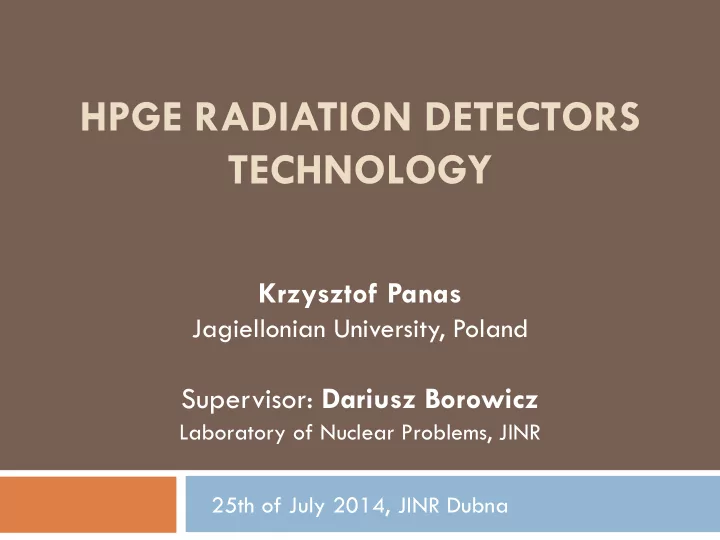

HPGE RADIATION DETECTORS TECHNOLOGY Krzysztof Panas Jagiellonian University, Poland Supervisor: Dariusz Borowicz Laboratory of Nuclear Problems, JINR 25th of July 2014, JINR Dubna
Presentation agenda Introduction 1. Geometry of the detector 2. Measurements: 3. Reverse current 1. Energy resolution 2. Acknowledgements 4.
Introduction High purity germanium detectors (HPGe) - best energy resolution among all detector types In principle, they work like reverse biased diodes; energy deposition by nuclear radiation causes flow of a current, which is processed by front-end electronics The aim of the project was to measure the performance of small-contact large volume HPGe detector manufactured in JINR
Geometry of the detector Fig. Geometrical dimensions of the Fig. Photography of the investigated investigeted detector (in mm) detector Source: Brudanin, V. B., et al. "Large-volume HPGe detectors for rare events with a low deposited energy." Instruments and Experimental Techniques 54.4 (2011): 470-472 .
Reverse current measurements Reverse (dark) current – a current flowing through the detector while it is reverse biased 14 12 Reverse current I [nA] 10 8 After cleaning 6 Before cleaning 4 2 0 0 500 1000 1500 Bias voltage U [V]
Energy resolution measurements Fig. Co- 60 spectrum measured with „warm” preamplifier @ U = 800 V.
Energy resolution measurements cont’d Fig. Measured FWHM of the Co-60 1332 keV peak.
Energy resolution measurements cont’d Fig. Co- 60 spectrum measured with „cold” preamplifier @ U = 800 V.
Energy resolution measurements cont’d Fig. Measured FWHM of the Co-60 1332 keV peak.
Acknowledgements To: dr Władysław Chmielewski and dr hab. Roman Zawodny University Centre director dr Stanislav Z. Pakuliak Dariusz Borowicz
Recommend
More recommend